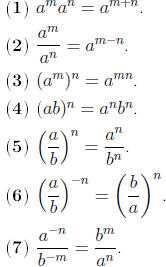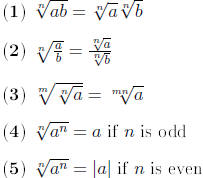Exponents and Radicals
Exponential Notation
If a is any real number and n is a positive integer, then the nth power of a is

The number a is called the base and n is called the exponent.
Zero and Negative Exponents
If a ≠ 0 is any real number and n is a positive integer, then

Laws of Exponents

Example 1. Evaluate the expressions

Example 2. Simplify the expressions

Solution.
 |
law 4 and 3 |
 |
rearrange factors |
 |
factor 6 and use law 1 |
 |
|
 |
definition of negative exponents |
Radicals
 means b2 = a and b ≥ 0.
means b2 = a and b ≥ 0.
Example.
 , since 32 = 9 and 3 ≥0.
, since 32 = 9 and 3 ≥0.
Definition of nth Root
If n > 1 is a positive integer, then the principal nth root of a,
denoted by  is
is
(1) 0 if a = 0.
(2) the positive number b such that bn = a, if a is positive.
(3) (a) the negative number b such that bn = a, if n is odd and a is negative.
(b) not a real number if n is even and a is positive.
If n is even, we must have a ≥ 0 and b ≥ 0. Complex
numbers are needed to define  if
if
a < 0 and n is an even positive integer, because when n is even for all real
numbers b, we
have bn ≥ 0.
If n = 2 we write  instead of
instead of
 .
.
Example.  since 33 = 81 and 3 ≥ 0.
since 33 = 81 and 3 ≥ 0.
Example.  since (-2)3 = -8.
since (-2)3 = -8.
Note that  are not defined as real numbers.
are not defined as real numbers.
Properties of nth Roots

Note that we have  . For
example,
. For
example,
Rational Exponents
Definition. If m and n are integers and n > 1, and if a is a real
number such that 
exists, we define
 or equivalently
or equivalently

Note that by the definition 
Remark. The laws of exponents hold for rational exponents also.
Example Evaluate the expressions

Example Simplify the expressions

Example Simplify the expression and
eliminate any negative exponent(s).
Rationalizing the Denominator
Rationalizing the denominator is to eliminate the radical in a
denominator by multiplying
both numerator and denominator by an appropriate expression.
Example. 
In general, if the denominator is of the form n with m < n, then multiplying the
with m < n, then multiplying the
numerator and denominator by 
Example Rationalize the denominator

More Examples. Simplify the expressions and
eliminate any negative exponent(s)
